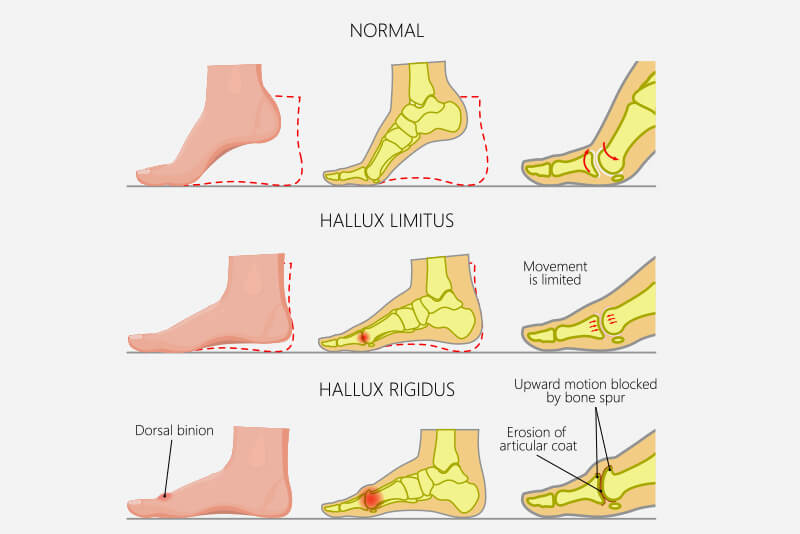Big toe stiffness and soreness might seem minor, but it can significantly impact your daily activities, especially if the condition worsens over time. These symptoms may point to a common foot issue called Hallux Limitus. Let’s explore what this condition is, its causes, symptoms, and treatment options.
What Is It?
Hallux Limitus is a medical term for limited movement in the big toe joint. This condition can start with mild discomfort and reduced flexibility but can progress into a more severe form known as Hallux Rigidus, where the joint becomes almost immobile. Hallux Limitus often affects the metatarsophalangeal (MTP) joint, the area where the big toe connects to the foot, causing pain and stiffness that can make walking or standing challenging.

What Causes Hallux Limitus?
Several factors can contribute to Hallux Limitus, including:
- Arthritis: Wear and tear in the joint can lead to inflammation and stiffness.
- Genetics: A family history of foot problems increases your risk.
- Overuse or Injury: Repetitive stress from sports or trauma to the toe joint can damage cartilage.
- Foot Structure: Flat feet or abnormal foot mechanics can put extra strain on the big toe joint.
- Ill-fitting Shoes: Shoes with a narrow toe box or high heels can exacerbate the condition.
What Are the Symptoms of Hallux Limitus?
Symptoms can vary, but common signs include:
- Stiffness and reduced range of motion in the big toe.
- Pain during walking, standing, or bending the toe.
- Swelling or inflammation around the big toe joint.
- A visible bump or bone spur on the top of the foot.
- Difficulty wearing shoes due to pain or joint stiffness.
Treatment of Hallux Limitus
Treatment for Hallux Limitus depends on the severity of the condition:
- Non-Surgical Options:
- Orthotics: Custom shoe inserts can help reduce pressure on the big toe joint.
- Physical Therapy: Stretching and strengthening exercises can improve joint mobility.
- Medications: Anti-inflammatory drugs may help relieve pain and swelling.
- Shoe Modifications: Wearing supportive shoes with a wide toe box can alleviate symptoms.
- Surgical Treatment:
- If non-surgical methods fail, procedures such as a cheilectomy (removal of bone spurs) or joint fusion may be necessary to restore function and reduce pain.
Final Thoughts
If your big toe is stiff and sore, it’s essential to address the problem before it worsens. Hallux Limitus can significantly impact your quality of life, but with the right treatment, you can regain mobility and comfort.
The Southwest Foot and Ankle Center specializes in treating chronic foot conditions like Hallux Limitus. With years of expertise and advanced treatment options, our team is dedicated to helping you walk pain-free.
Contact Southwest Foot and Ankle Center today to schedule a consultation and take the first step toward healthier, happier feet!
Contact us
Schedule an appointment
with our podiatrist by contacting us or calling our:
